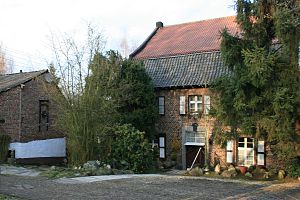Talmühle (Dremmen)
| Talmühle (Dremmen)
|
||
|---|---|---|
| Location and history | ||
|
|
||
| Coordinates | 51 ° 2 '28 " N , 6 ° 9' 26" E | |
| Location | Germany | |
| Waters | Worm , boy worm | |
| Built | before 1461 | |
| Shut down | around 1945 | |
| Status | Monument protection | |
| technology | ||
| use | Oil and grinder mill | |
| Grinder | 1 grind 1 oil press | |
| drive | 1 water wheel | |
| water wheel | undershot | |
The valley mill was a watermill on the Junge Wurm . It is located in the town of Heinsberg in the North Rhine-Westphalian district of Heinsberg in the administrative district of Cologne .
geography
The Talmuhle had its location on the boys worm , at the Talmühlenstraße, in the district Dremmen in the town of Heinsberg. The property on which the mill building stands is approx. 49 m above sea level . In front of the mill was a mill pond. Above was the Horster mill in Horst , below was the location of the Liecker mill in Dremmen.
Waters
The Junge Wurm was a body of water that ran more or less parallel to the Wurm . The junction from the Wurm was in Nirm, a district of the city of Geilenkirchen . Here the worm has a height of 54 m above sea level. The river Junge Wurm, also known as the Kleine Wurm , flowed in a north-northwest direction via Randerath , Horst , Porselen , Dremmen , Grebben , Heinsberg , Kempen and Karken across the German - Dutch border towards Vlodrop and empties at an altitude of 29 m above sea level on Dutch territory into the Rur . It was a natural body of water in which humans had a hand in many places. The Junge Wurm was connected to the Heinsberg moat , the mill canal, the Liecker brook and the mill brook . This composite body of water served for surface drainage and the benefit of the people. For centuries there were around 15 water mills on the Junge Wurm, with a slope of 26 m between Randerath and Karken. With the worm straightening in the 1960s and 1970s, the young worm disappeared from the maps . Instead, drainage channels and trenches were created. The water association Eifel-Rur (WVER) is responsible for the care and maintenance of the water body with a catchment area of 355.518 km 2 .
history
The sovereign oil mill was first mentioned in 1461. She had to deliver 25 quarts of oil (about 22 liters) to the Duchy of Jülich every year . In 1806 the oil mill, which was equipped with a mill ban , was converted into a grinding mill with two water wheels and two grinding stages by the Horster millers family Lambertz . The mill worked until January 1945; then significant parts of Dremmen and Heinsberg were destroyed by Western Allied air strikes and artillery shells as part of Operation Peacock .
The mill building and a water wheel were preserved; they are under monument protection .
Monument entry
Talmühle Dremmen Hof und Mühle : Four- winged brick courtyard, main building has two floors with three axes, mansard roof , gable side with three to four axes. Stem with mill wheel. From the first half of the 18th century, wooden door from the end of the 18th century, two-storey, three-wing half-timbered structure - forecourt. Entry in the list of monuments on January 16, 1984.
gallery
Talmühle on the Tranchot map 1806/1807
See also
literature
- Hans Vogt: Lower Rhine water mill guide 2nd edition. Verein Niederrhein, Krefeld 1998, ISBN 3-00-002906-0 , pages 305-306.
Web links
Footnotes
- ^ German basic map 1: 5000
- ↑ Archived copy ( memento of the original from October 17, 2013 in the Internet Archive ) Info: The archive link was inserted automatically and has not yet been checked. Please check the original and archive link according to the instructions and then remove this notice.
- ↑ http://www.wver.de/
- ↑ Photos and text







